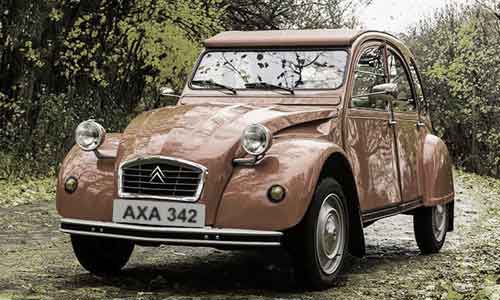The World's Strangest Cars
The biggest! The weirdest! The craziest! Etc etc etc
Click here for cheap UK car insurance!
The 2cv - Horrible But Very, Very Successful!
The Origins of the 2CV
In the 1920s most French country roads were in pretty poor condition, not helped by the devastation caused by World War I. Rural transport was mainly via horse and cart, and the management of Citroen recognise that there was a need for cheap, reliable motorised transport to help the farmers take their produce to and from markets. The Citroen 2CV was intended from the first to be strong, durable vehicle; easy to maintain, economical to run, capable of carrying up to 4 people as well as 50 kg of goods, and able to drive on roads in poor condition, with a reasonable degree of comfort. Unfortunately the company went bankrupt; but the major shareholder, Michelin (now a major tyre manufacturer) took over the project. By 1937 a number of prototypes of the TPV (Very Small Car; Toute Petite Voiture in French) had been produced.
How was it made?
Much of the bodywork was corrugated, in order to increase strength without increasing weight. The roof was made of canvas, which could be rolled back so that bulky goods could be carried. Seats were mere hammocks (later models would feature seats which could be removed and used for picnics!). The vehicles had a high ground clearance which enabled them to cross rough ground and the engine was surprisingly reliable, easy to maintain, and capable of being driven at around 30 mph with up to 80 miles from every gallon of petrol.
The 2CV in WW2
Although the vehicle was supposed to be launched in 1939, the outbreak of World War II put a stop to it. The management of Michelin didn't want the Germans to be able use the car to benefit their war efforts, and many of the prototypes were deliberately destroyed in order to keep them out of enemy hands. Senior Citroen executives refused to cooperate with the Germans, at great risk their own personal safety. The machine tools were looted from their factories for transportation to Germany, and it was only with the assistance of the French resistance that this was sabotaged. Nevertheless by the end of the war much of the essential equipment had been either destroyed or removed and it was not until 1948 that the car could be exhibited at the Paris motor show, to be put on sale a year later.
Why was it so ugly?
These cars were rudimentary to say the least; with a 375 cc engine producing just 9 hp, and a top speed of around 40 mph, it had just a single taillight and one single windscreen wiper, the speed of which was dependent upon the speed of the car. The motoring press decried it as ugly, and it was available only in grey. However, in austerity France the combination of relatively low price, simple maintenance, low running costs and robustness make the 2CV (as it had been renamed) extremely popular; a five year waiting list quickly developed and second-hand vehicles were soon changing hands at a higher price than that of a new vehicle.
Twin engines? Surely not.
yes, in 1958 an off-road version was produced with not only an engine in the front but one in the boot as well! Getting this to work was a nightmare for the designers and it pushed costs - and the selling price - up considerably. Sales figures were dismal. A few were sold to the Spanish police and even fewer to the Swiss postal service and that was about it.
Commercial Success
Despite its criticisms and drawbacks the 2CV was a huge commercial success and nearly 9,000,000 of the original design were built, with factories in France, Portugal, Britain, Spain, and South America feeding the demand for low-cost transport. Delivery van versions were produced, which again proved very popular.
The end of the era
It was not until 1988, when a combination of ageing, inefficient machine tools made production at the French factory uneconomical. Production there ceased, although it continued at the more modern factory in Portugal for a further two years. By this time new emission standards were coming into force throughout Europe, and since the car was incapable of meeting the standards without considerable redesign, manufacture of the two CV and it's siblings finally came to an end (Sob!).
